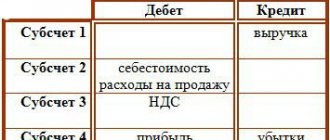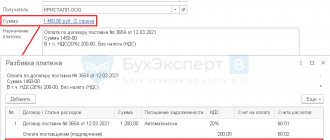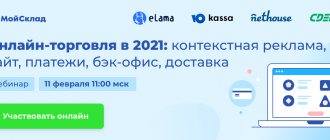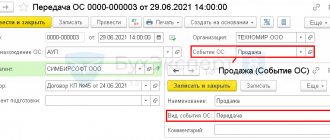Who pays for what?
VAT stands for value added tax. Accrued upon the sale of goods, works, services to the buyer. Belongs to the group of indirect taxes. This means that the real payer is not the one who transfers money to the budget and fills out the declaration, but the end consumer of the product/work/service, i.e. you and me.
The last statement requires clarification. To do this, you need to understand the mechanism of VAT formation. A simple “producer-consumer” chain looks like this:
- Papa Carlo bought a log from Giuseppe to make a wooden doll. It cost 240 rubles. At the same time, 40 ₽ is the 20% VAT accrued by Giuseppe.
- Papa Carlo made a doll and sold it for 600 ₽, including 100 ₽ tax.
- Mom bought her daughter a toy for 600 rubles, paying dad Carlo including tax. She is the final VAT payer.
- Papa Carlo must transfer an amount of 60 rubles (100 – 40) to the budget.
The bottom line is that the state wants to receive 20% of the price of the product. In our case, my mother bought a doll for 600 ₽. This is the price (500 ₽) + 20% VAT (100 ₽). Then why did Papa Carlo pay the tax office only 60 rubles? The fact is that the remaining 40 rubles were already transferred to the state by Giuseppe.
Let's go through the chain again. Where will Papa Carlo get the money to transfer to the budget:
- his mother will pay him 100 ₽ when buying a doll;
- Papa Carlo will give 40 ₽ to Giuseppe;
- the remaining 60 ₽ will be transferred to the budget;
- in total, dad Carlo will pay 100 rubles (60 to the state and 40 to Giuseppe), which is exactly how much the girl’s mother gave him.
Value added tax is called indirect tax. Unlike a direct tax, it is financed by the final buyer (in our case, the girl’s mother), and the seller (in our case, Giuseppe and Carlo’s dad) transfers it. Excise taxes work on the same principle.
VAT came to us from France. It was invented by Maurice Lauret in the mid-20th century. In Russia it has been valid since January 1, 1992.
Now let’s turn to the official source, let’s look at who pays VAT and what it is charged on. The procedure for calculation and payment is defined in Chapter 21 of the Tax Code.
Payers:
- Enterprises and organizations of all forms of ownership, including non-profit ones.
- Individual entrepreneurs.
These two groups have one requirement in common - they must be on a common taxation system. But there is a third group, which includes payers regardless of the taxation system they use. They are required to pay tax when importing goods from abroad (import).
After reading, you will understand how to stop working for pennies at a job you don’t like and start LIVING truly freely and with pleasure!
The objects of taxation are:
- sale of goods, works, services on the territory of the Russian Federation, including free of charge;
- import of goods;
- performing construction and installation work for one’s own needs;
- transfer of goods (performance of work, provision of services) for one’s own needs, the costs of which are not taken into account when calculating income tax.
Tax scheme: myth about VAT savings
Reverse agency scheme: a myth about VAT savings
Some tax consultants offer a method of tax optimization called a reverse agency scheme. Among its benefits is VAT savings. Actually this is not true.
The essence of the scheme: Agent LLC is created in a special mode (or individual entrepreneur, if cash is needed). An agency agreement, unlike a direct scheme, is concluded not with Trading House LLC, but with its clients. The subject of the agreement is the search for suppliers. The sale of goods to a client from Trading House LLC is carried out not at the price list, but at a discount. The discount amount is paid by the client to the agent as a commission. As a result, part of the proceeds is immediately transferred to a low-tax entity.
Application: I have seen two different applications of the reverse agent circuit.
Instead of selling the goods at a price of 118.00 (incl. VAT 18.00) rubles, the goods are sold at a price of 100.00 (incl. VAT 15.25) rubles and the agent receives 18.00 rubles as a commission for finding a supplier from the client. As a result, the same 118 rubles were received from the client, but 15.25 rubles were paid to the budget, not 18. VAT savings of 2.75 rubles.
The savings are achieved at the expense of your client. Because, with the same cost of goods, he can deduct 2.75 rubles less. Therefore, this option is only possible in the case when your client does not quite clearly consider the “correct” price (net of taxes). Well, or the person making the decision on the client’s part, intentionally or unknowingly, does not quite correctly assess the amount of the transaction.
In this version, the reverse agency scheme operates similarly to a retro bonus. Many suppliers who pay their client a retro bonus at the end of the period do not realize that they are not only making a discount on the amount of the retro bonus, but also paying additional VAT for their client. The retro bonus shifts the VAT burden from the buyer to the supplier, while the reverse agency scheme shifts the VAT from the supplier to the buyer.
I came across this scheme from one very popular tax consultant. Savings here are achieved due to the fact that VAT is not paid on the margin of shipments to simplified clients. The reverse agency scheme itself does not provide tax optimization here. It is only an option for implementing a “simplified” sales arm. Compared to the classic version of the scheme
the reverse agency scheme allows you to bypass the restrictions on the sales limit for simplified companies of 150 million rubles. For an agent, not the entire sales amount is subject to a limit, but only the commission amount.
Application Analysis:
1. The reverse agency scheme itself does not optimize VAT. It either simply “shifts” the tax burden, or is a technical component of the scheme. If you do not have the opportunity to transfer part of your sales to the tax-free area, then the potential for using a reverse agency scheme is zero.
2. It will be very difficult to convince your clients to enter into an agency agreement instead of a purchase and sale agreement. This agreement causes a persistent allergy among accountants (in addition to the usual fear of risks, it also complicates document flow) and is “on the pencil” of bankers. In a competitive environment, this will be a serious disadvantage for your company.
3. In accordance with Ch. 52 of the Civil Code of the Russian Federation The Agent acts in the interests and at the expense of the Principal, and in this case it is the client. It will be very difficult to “play” the real control of the agent to the company’s management. The negative effect of agent-supplier interdependence will increase. In the case of a reverse agent, it is better to avoid it altogether, which adds problems when structuring.
4. In general, the business purpose of the scheme with clients appears dubious, especially if they purchase a significantly wider range of goods than is supplied by the agent. If you have your own supply structures, there is no point in giving a separate item for procurement to an external agent.
5. The sales business process differs significantly from the procurement business process (in general, if we do not consider individual “monopoly” cases). Therefore, the interaction between company employees and clients will not correspond to the subject of the contract.
“Sales people” make regular calls to customers regarding new applications that have appeared, and send information about various promotions and new products. At the same time, they “usually” highlight the advantages of their product and “belittle” the products of competitors. Buyers behave differently. They wait for the application to appear and, based on it, work with various suppliers. They send requests, analyze offers, and negotiate price reductions. These discrepancies can be easily identified through surveys of agent employees and clients, correspondence analysis, and CRM automation programs.
6. We won’t even discuss the risks associated with additional questions from tax authorities.
Conclusion: the reverse agency scheme has a very narrow and specific scope of application. For example, in cases where customers are to some extent controlled by the supplier. In cases consistent with business customs, the use of a reverse agency scheme seems inappropriate.
If your legal dispute or other dispute, contractual work or any other form of activity concerns the issues discussed in this or other of our material, we recommend that you check and make sure that your legal position complies with the latest changes in practice and legislation.
We will be happy to provide you with legal assistance regarding minimizing legal risks and available opportunities. We will try to find a solution that suits you.
Call +7 (383) 310-38-76 or write to
September 25, 2017
Kirill Soppa , partner. I deal with taxes, I like to build business processes. I write articles, look for interesting information and suggest ways to use it in practice. I believe that thanks to high-quality legal analytics, clients come to a law firm, and not vice versa. Do you agree? Then let's be friends on Facebook.
Interesting materials on tax law (disputes, issues):
1) withdrawal of enterprise assets;
2) 4 tax schemes for splitting a business to optimize taxes;
3) practice of collecting taxes from interdependent persons based on an analysis of popular court cases;
4) analysis of schemes for the sale of shares in the management companies of companies and the calculation of VAT;
5) the law on CFC using the example of IT companies;
6) cashing out funds: tax and criminal legal risks;
7) refund of overpayment of income tax;
 payments not subject to insurance premiums;
payments not subject to insurance premiums;
9) compensation for damages for tax crimes;
10) evasion of taxes from an organization (practice under Article 199 of the Criminal Code of the Russian Federation);
11) intentional non-payment of taxes (clause 3 of Article 122 of the Tax Code of the Russian Federation);
12) abolmed: analysis of tax problems;
13) business structuring is a tax security tool.
If you liked this material or any of our others, then recommend them to your colleagues, acquaintances, friends or business partners.
Share
Share
Tweet
Class
Plus
We recommend reading our blog dedicated to legal and judicial cases (arbitration practice) and reading the materials in the “Articles” Section.
Our law firm provides various legal services in different cities of Russia (including Novosibirsk, Tomsk, Omsk, Barnaul, Krasnoyarsk, Kemerovo, Novokuznetsk, Irkutsk, Chita, Vladivostok, Moscow, St. Petersburg, Yekaterinburg, Nizhny Novgorod, Kazan, Samara, Chelyabinsk, Rostov-on-Don, Ufa, Volgograd, Perm, Voronezh, Saratov, Krasnodar, Togliatti, Sochi).
We will be glad to see you among our clients!
Call or write right now!
Telephone Email address
Legal is more than just legal services
Tax benefits
Since there are those who pay, it means that there are those who are exempt from this obligation. Benefits will be received by legal entities and individual entrepreneurs:
- whose revenue for the previous 3 months did not exceed a total of 2 million rubles (exemption is given for 1 year);
- that use special tax regimes (Unified Agricultural Tax, simplified tax system, patent system, UTII);
- received the status of participant in the Skolkovo project.
Article 149 of the Tax Code of the Russian Federation provides a detailed list of transactions that are not subject to VAT. Among them, for example, the implementation:
- medical and prosthetic and orthopedic products, technical means for the prevention and rehabilitation of disabled people, glasses, frames and lenses for vision correction;
- medical services (there are exceptions);
- care services for the elderly, disabled, and sick;
- services for maintaining children in kindergartens, classes in clubs, sections, etc.;
- transport services (with the exception of taxis, including minibuses);
- funeral services;
- coins made of precious metals.
VAT exemption
Companies without import operations and excisable goods can submit an application and be exempt from paying VAT on certain operations or activities (Article 145 of the Tax Code of the Russian Federation). To do this, a condition must be met: the company’s revenue excluding VAT should not exceed 2 million rubles for three consecutive calendar months. If this limit is exceeded, the right to the privilege “burns out.”
There is also an exemption from VAT for certain types of goods and services (Article 149 of the Tax Code of the Russian Federation). These include medical services, care for the disabled, child care, arts services, and research and development. Study the list of operations in Art. 149, you may find your products or services there.
Rates
In Russia there are 3 rates for value added tax.
- 0 %
Valid for goods and services sold for export. A rather impressive list is presented in Article 164, paragraph 1 of the Tax Code of the Russian Federation.
- 10 %
It is used in the sale of food products, goods for children, books and periodicals (newspapers, magazines), medical goods. There are exceptions to each point. For example, 10% will be taken from the sale of vegetable oil, but 20% from palm oil, 10% from fish, but 20% from its valuable species: salmon, sturgeon, salmon, etc.
- 20 %
For all other goods/works/services that are not included in the list of preferential taxation, the rate will be 20%.
Calculation formula
The tax is calculated along the chain: each manufacturer, when selling his product/work/service, charges a tax and subtracts from the amount received the tax previously paid to his supplier.
Calculation formula:
VAT payable = Output VAT – Input VAT + Recovered VAT
Outgoing – the amount of tax that the seller will receive from his buyer. It is calculated as the product of the tax base and rate. For example, we sold goods worth 1 million rubles, plus 20% VAT (0.2 million rubles).
Input – tax that was paid in the price of the goods/work/service of the supplier. For example, we bought raw materials for 1.2 million rubles, including VAT of 0.2 million rubles allocated in the supply invoice.
Recovered is a tax that must be returned to the budget. Situations when this happens are described in Article 170, paragraph 3 of the Tax Code of the Russian Federation.
Let's look at tax calculation using an example. Let's not go far from Giuseppe (he will turn into a logging company) and Papa Carlo (he will become a manufacturer of handmade log cabins). In addition to Giuseppe, other suppliers (tools, equipment, other raw materials and materials necessary for the production of houses) will definitely appear in the chain. Let’s combine them into one company and call it “Domostroy”:
- The Giuseppe company supplied logs worth 500 thousand rubles, plus 100 thousand rubles VAT. The Papa Carlo company received an invoice totaling 600 thousand rubles.
- The Papa Carlo company purchased everything necessary for the production of the house from the Domostroy company. She issued an invoice for 120 thousand ₽, including VAT - 20 thousand ₽.
- The Papa Carlo company made a house, took into account material costs, salaries for its employees and other expenses in the cost price, and added profit. The result was 1 million rubles. VAT of 0.2 million rubles also had to be charged on it. In total, the buyer will pay 1.2 million rubles for the house.
VAT payable = 200,000 – (100,000 + 20,000) = 80,000 ₽, where:
- 200,000 – output tax received from the buyer of the house;
- 100,000 – input tax received from the Giuseppe company;
- 20,000 – input tax received from the Domostroy company.
Companies that are value added tax payers prefer to work with the same payers. If an invoice without VAT appears in the settlement chain (for example, from an individual entrepreneur on a simplified taxation system), then there will be nothing to deduct from the outgoing one - the company will not receive any tax deduction.
With a zero tax rate comes another procedure that some businesses go through: refunds. Let's imagine a situation where our dad Carlo sells goods abroad. In this case, the VAT rate will be 0%. But he bought the raw materials and consumables from the supplier and received the input tax.
If you use the standard formula, you will get a negative amount payable. For example, based on our example above:
VAT payable = 0 – (100,000 + 20,000) = – 120,000 ₽
Consequently, it is not Papa Carlo who owes the budget, but the budget to him. The amount of RUB 120,000 is refundable. This is not an easy procedure. The state must make sure that it is not being deceived. It takes a long time to check documents and schedule on-site inspections if in doubt, so the company must approach preparations with all responsibility and not give reason to doubt its honest intentions.
VAT optimization in 2021: schemes, options
The high VAT tax rate for the year does not cause delight among businessmen. Moreover, many of them do not refuse to pay taxes, but note their high cost to the company’s budget. This is why tax optimization of VAT is becoming increasingly popular today. The service involves reducing taxation costs and optimizing them, but without conflict with current legislation and regulatory authorities.









